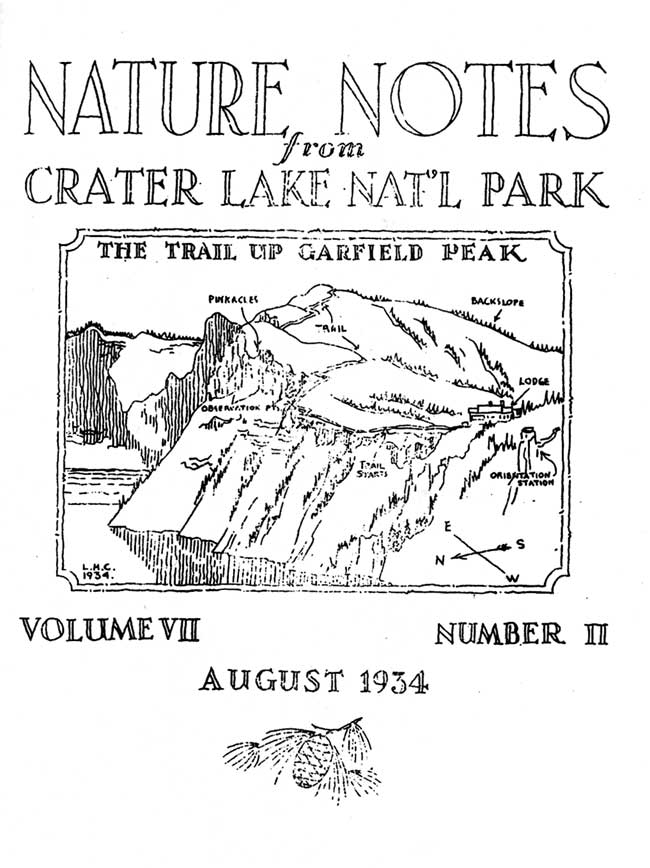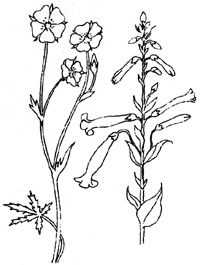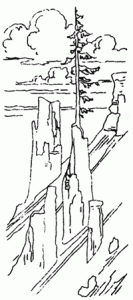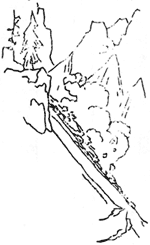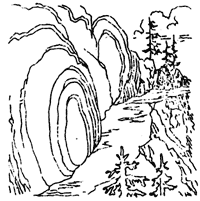Volume 7 No.2 – August 1, 1934
All material courtesy of the National Park Service.These publications can also be found at http://npshistory.com/
Nature Notes is produced by the National Park Service. © 1934
The Trailside Speaks
For those who have observant eyes and ears, the trailside speaks with many voices. Hundreds of stories of struggle and force are strewn along the ascent of Garfield. It is one thing to see the sign of the story; it is another to interpret it. On our way up the Peak this morning, let us look only for the signs of stories. As we begin the ascent, our eyes are drawn to a continuous spiral scar that encircles as a majestic hemlock from crown to base. The scar is fresh, exposing the lighter colored cambium layer. A story is here – a story of tremendous force and potential devastation, for lighting is one of the greatest foes of our forest areas. Crossing a barren ash slope further on, we find that it is dotted with Newberry’s knotweed and sulphur flowers. The botanist, could he uproot one of these plants, would illustrate by means of the root system an interesting tale of adaptation to arid conditions. Swinging up to the Rim again, our eyes are arrested by white bark pines stretching out over the brink in a horizontal position. Why are these plants not growing upright? The barren slope behind us and the exposed situation give us a hint to the story here, and a winter view of this spot would make it clear, for the combination of snow and wind has contributed to the position of these trees.
Moving along up the slope, we are startled by a sharp whistle close at hand. We look in vain for the source, and the dull browns and grays of the rock slide, tell us something of the marmot’s color, for surely nothing could be so close and yet invisible. We pass clusters of penstemon and potentilla side by side. A blur of motion hovers over the penstemon. We stop for a moment to observe that the potentilla holds no attraction for the humming bird. Why is this? The ornithologists could tell us the answer and it would be the story of the adaptation of plants to different means of pollenization.
Continuing upward, we pass an exposed ledge of rock whose material lies in well defined thin horizontal layers. To the ordinary observer it appears as a stack of huge plates, but the geologist knows that minerals and stresses entered into the formation of this curious mass. A few feet further on and we find ourselves with the placed Lake fourteen hundred feet below us.
Our eyes are drawn upward from the Lake along the profile of the tawny cliff that towers above us to the right. The whole scene has such an appearance of immobility that our eyes are caught by the slightest movement. Far out on the face of the cliff, standing on the top of a small upright pinnacle, a swaying pine tree attracts our attention. Miniature drama is represented in the situation, for we are observing the struggle between two forces: the forces of growth and the forces of destruction. Which will triumph? As we stand, wondering, from far below comes up to us the sound as of a snapping, crackling fire newly kindled, and we know that sound as audible proof that the forces of destruction are at work, for a rock slide is on its way to the Lake. We resume our walk, and from the rock wall that lines the side, the sun strikes back into our eyes from a small spot that shines like an opal. Here is an interesting story of the relationship between rocks and the weather, for without the winter’s snows melting far above this point, these spots would not have been formed.
Glancing upward we glimpse the summit and hurry on, eager for the view from the top. Our sleeves brush a tree that appears familiar but yet strange. Is it a pine? We examine the foliage. It is a hemlock and apparently mature, yet it is but a pigmy six foot brother to the majestic hemlocks that line the trail and the base of the peak. Why is it so small? The answer might be had from the botanist, who in answering would unfold the story of vegetation adaptation from the Arctic to Mexico.
At last we reach the top. To the south we can look into California and to the north we follow the profile line of the Cascade Summit, but our eyes return each time to the blue marvel at our feet, two thousand feet below us. We do not wish to think now. We wish only to gaze at this example of titanic force from the past, and comprehend, if we can, its present, living beauty.
The Geology of the Garfield Trail
By Carl R. Swartzlow, Ranger-Naturalist
The Garfield Trail speaks in many languages. The song of the birds and the rustle of the breezes through the hemlocks and pines are the first sounds to great the ear, and they follow one all the way. This language is also expressed in less musical tones. As one approaches the Rim and looks toward the Lake, a rumbling sound is heard and attracts the attention to boulders, loosened by erosion, tumbling to the narrow beach at the water’s edge. Jets of dust rise at points where the boulders strike on their downward journey. It is only after gazing at the inner Rim for several minutes that the grandeur of the scene unfolds and one realizes that the landscape of color dominates this trailside.
The Garfield Peak Trail may be called a study in brown. From the point where one first ascends the trail, thence to the top of the peak, one is constantly impressed by the ever changing shades of red, brown, and yellow. The causes for this particular series of colors are related to the most fundamental processes of geology an should be a part of the knowledge of every lover of the out of doors.
The reds and browns of the rocks along the trail are usually a result of the first stages of rock decay, and all subsequent compounds released are stained with these colors. The constituents of the pigments are oxygen, iron, and water. The iron oxides (iron united with oxygen) are a constituent of nearly every variety of igneous rock. Iron may not be a diagnostic element in some varieties of rock but its presence is all but universal. The abundance of iron oxide determines in a large measure the depth of color found in the weathered rock products.
Usually the iron in fresh rocks is not fully united with oxygen, i.e., oxidation is not complete and in this state the iron is soluble and is relatively colorless. Moisture that comes in contact with rocks has previously dissolved varying amounts of the atmospheric gases, of which oxygen is a common constituent. The oxygen in the water unites with the iron of the rocks and produces a compound in which the iron has taken on all the oxygen possibly and in this latter state is one of nature’s most insoluble compounds. If water as such has united with the iron oxide the resulting compound (the mineral limonite) has a brown color, and if the compound is diluted the resulting color is yellow. If no water has entered into the reaction, the color of the resulting rock is red – the mineral hematite. If the soluble and insoluble iron compounds are mixed a greenish color is produced. It can be seen readily that combinations of these colors in various stages of dilution can produce an infinite variety of shades that enhance the beauty of the trailside.
At the beginning of the Garfield Trail one walks over a mass of buff-to-tan pumice dust. Undecomposed fragments of this volcanic glass reflect the sunlight as if the pumice contained myriads of diamond chips. In time their lustre will be dulled by the chemical action of the atmosphere or by organic acids released by decaying vegetation. The pumice soils contribute little essential plant food, and only the more hardy grasses and flowers are found growing upon them. Where abundant vegetation appears to be growing in pumice, the plants are usually rooted in more fertile soils below.
A few yards beyond the point where the trail first touches the Rim, and at several other points along the trail, the lava rocks (mainly andesite agglomerate) have been decomposed and young soils have been formed. These soils have a chalky appearance in contrast to the usual yellow or brown soil along the trail. These formations are seldom a result of normal weathering processes, but are probably due to the action of heated waters that escaped along the slopes of Mt. Mazama. The rocks have been almost completely decomposed. The residual material is the mineral kaolin or some variety of it. (Kaolin is the chief mineral constituent of clay). If one moistens his fingers and rubs them over some of these particles, a greasy or doughy ball of clay is readily formed.
About halfway to the top of the Peak there are additional examples of rock weathering that are more common but are none the less interesting. Large masses of volcanic agglomerate have been weathered for long periods of time by normal processes. In the construction of the trail, cuts have been made through the rock mass, and cross sections of many boulders are left to tell the steps that nature has used to bring about the changes from solid rock to soil. The sub-angular fragments of rock have clear outlines, but they can be crushed easily with the fingers.


